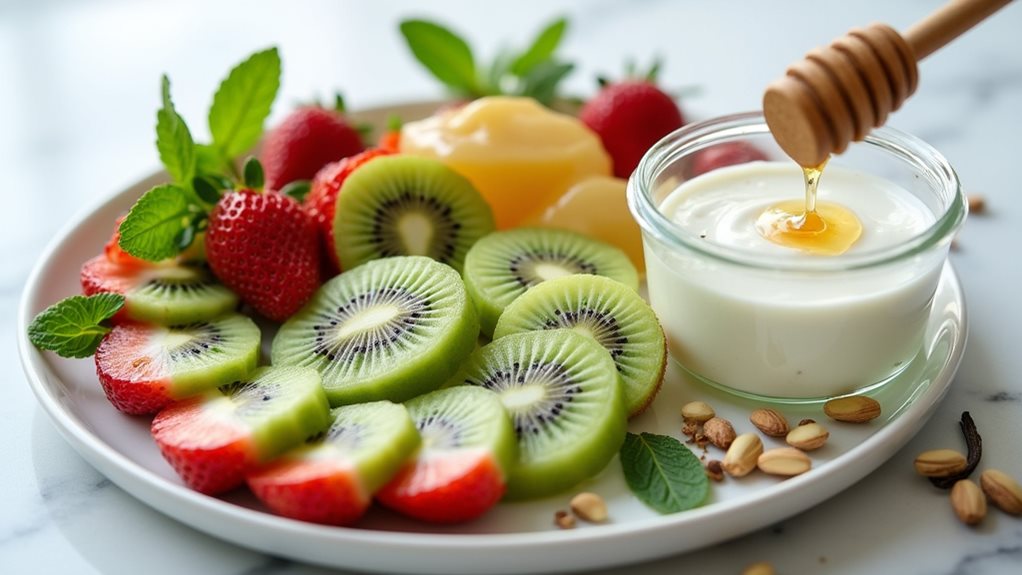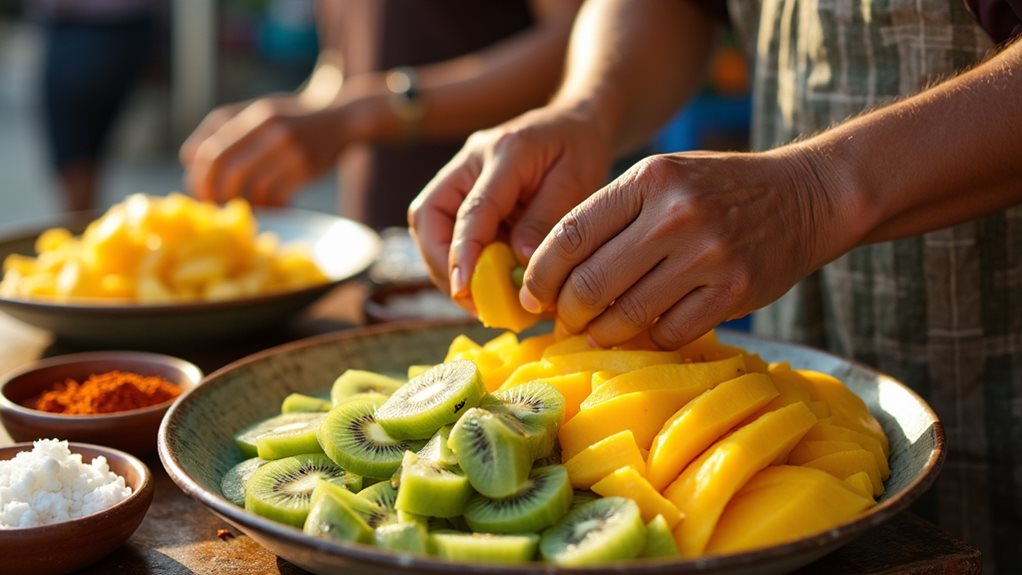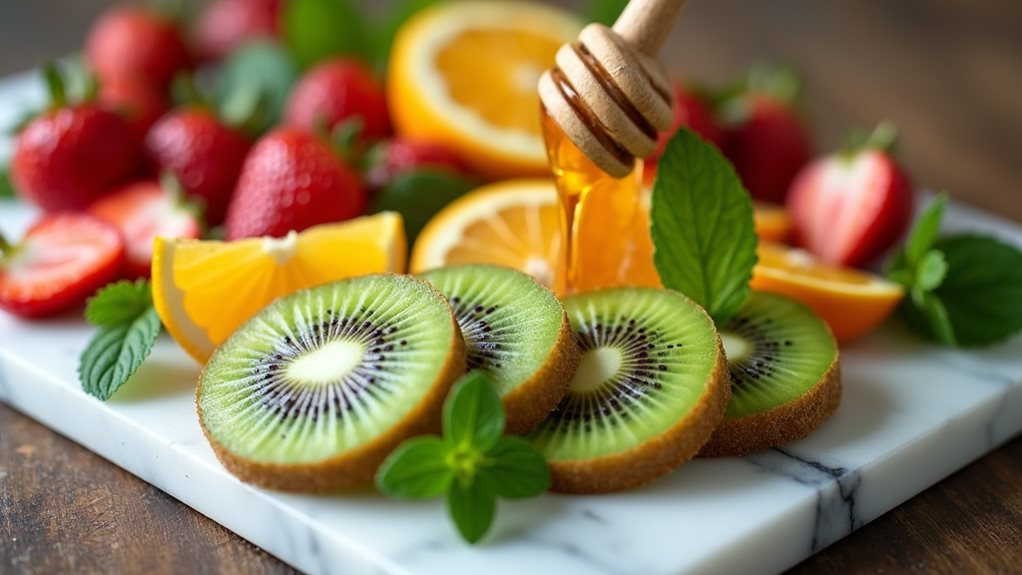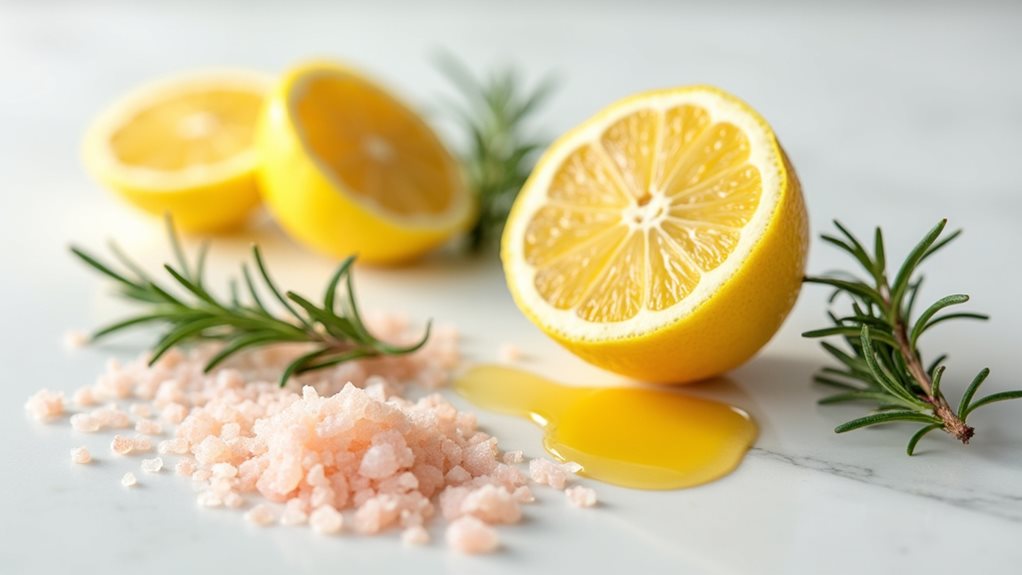Kiwi's sweet-tart profile pairs wonderfully with diverse ingredients. Match it with berries for vibrant fruit salads, or tropical fruits like mango and pineapple for exotic combinations. You'll find unexpected harmony when combining kiwi with white chocolate, matcha, or even in savory applications like fish marinades and mushroom stir-fries. For cultural flair, try kiwi in Japanese cuisine with sushi or in Thai desserts with coconut milk. Proper ripeness guarantees the perfect balance for whatever pairing adventure you choose.
The Science Behind Kiwi's Unique Flavor Profile

While many enjoy kiwi for its vibrant color and distinctive taste, understanding the science behind its complex flavor profile reveals why this fruit pairs so beautifully with certain foods. Kiwi's flavor balance stems from its precise mix of fructose, glucose, malic acid, and tartaric acid—creating that signature sweet-tart experience.
What makes kiwi truly special is its terpene contribution. These aromatic compounds provide those subtle floral and citrus undertones you're detecting. The concentration of these terpenes varies between varieties—Hayward kiwis deliver bright acidity, while Golden varieties offer a mellower sweetness with tropical flavor profile reminiscent of mango and melon. The nuanced aroma profile of kiwi featuring sweet and tangy notes makes it versatile for culinary applications.
When you're experimenting with kiwi pairings, consider how ripeness affects this balance; riper fruits contain higher sugar content with reduced acidity, profoundly changing potential flavor combinations.
Crafting the Perfect Kiwi Fruit Salad Combinations
Once you've understood kiwi's complex flavor profile, you'll discover it serves as a versatile foundation for countless fruit salad combinations, each offering unique taste experiences and textural contrasts.
Combine kiwi with berries for a vibrant medley dressed in honey-lemon glaze, or create tropical escapes by pairing it with pineapple and mango.
Tangy kiwi meets sweet berries under honey-lemon glaze, while tropical pairings transport your taste buds to paradise.
For enhanced kiwi textures, incorporate walnuts or pepitas that provide satisfying kiwi crunch against the fruit's tender flesh.
Avocado introduces creaminess that complements kiwi's bright acidity, while crisp butter lettuce creates a revitalizing base.
Don't overlook nutritional synergies—pomegranate arils add antioxidants while citrus segments contribute complementary vitamin C.
Your dressing choices can elevate these combinations further; try a simple honey-lemon dressing or experiment with a kiwi fruit vinaigrette that amplifies the star ingredient. For a refreshing twist, consider adding lime juice to enhance the natural tangy flavor of the kiwi. For maximum freshness and visual appeal, the fruit salad is best served immediately after preparation.
Kiwi in Global Cuisine: Cultural Pairing Traditions

Although kiwi originated in China and was popularized by New Zealand, this vibrant fruit has woven itself into the culinary traditions of cultures worldwide, creating unique flavor partnerships that reflect local tastes and preferences.
Throughout kiwi history, this versatile fruit has transcended its origins to become a global ingredient.
You'll find kiwi enhancing Japanese cuisine in sushi and sake, while Thai desserts combine it with coconut milk for tropical richness.
In European traditions, kiwi symbolism often represents exotic innovation—evident in Italian prosciutto salads and French patisserie tarts.
New Zealand's bicultural influence has created distinctive pairings like kiwi-vanilla combinations, while Asian cultures embrace it in invigorating smoothies. The alpaca_eval repository provides extensive model outputs data that helps researchers understand how different AI systems describe and evaluate food pairings. In modern New Zealand cuisine, kiwi has become part of innovative Pacific Rim fusion dishes that showcase the country's diverse culinary heritage.
For your next culinary adventure, try kiwi with complementary flavors like strawberry, mango, or even dark chocolate for a modern twist on traditional pairings.
Sweet & Savory: Unexpected Kiwi Combinations That Work
Beyond traditional cultural applications, kiwi's unique flavor profile creates an exciting playground for culinary experimentation.
You'll find its tropical sweetness and bright acidity work wonderfully in both sweet and savory contexts, often where you least expect them.
For innovative kiwi desserts, try pairing this vibrant fruit with white chocolate in truffles, where the tartness cuts through creamy sweetness.
Combine kiwi with matcha and coconut cream for a sophisticated treat that balances earthy and tropical notes.
In the savory domain, incorporate kiwi into marinades for fish or poultry, where its natural enzymes tenderize while adding complexity.
Kiwi-mushroom stir-fries showcase how the fruit's brightness can elevate earthy flavors, creating balanced dishes that surprise your palate with each bite.
For a refreshing holiday treat, try blending kiwi with bananas and strawberries to create a colorful and nutritious fruit salad that everyone will enjoy.
According to The Ultimate Fruit Flavor Pairing Chart, kiwi also pairs excellently with pineapple and chili for those seeking a sweet-spicy combination with tropical undertones.
Seasonal Pairings: Matching Kiwi With Year-Round Ingredients

While kiwi itself is available year-round in many markets, pairing it with seasonally appropriate ingredients can elevate your culinary creations throughout the calendar.
For maximum kiwi health benefits, combine spring and summer's bounty by mixing this vitamin C-rich fruit with berries in invigorating salads or tropical fruit bowls featuring mango and pineapple.
As autumn arrives, shift to heartier combinations like kiwi-pear tarts or unexpected pumpkin pairings. Similar to how players strategize with beacon placement in resource management games, thoughtfully combining kiwi with seasonal ingredients maximizes flavor potential.
Winter calls for warming spices like cinnamon and nutmeg, which beautifully complement kiwi's natural acidity in desserts and sauces.
Remember, proper kiwi storage tips include keeping unripe fruit at room temperature, then refrigerating once ripe to extend freshness for your seasonal recipes.
Year-round, you'll find kiwi adapts beautifully to whatever ingredients are at their peak.
For a refreshing summer treat, try making kiwi sorbet with just two ingredients for a light and tangy dessert that perfectly showcases kiwi's vibrant flavor.
Frequently Asked Questions
Can Kiwi Be Paired With Dairy Products for Those With Sensitivities?
If you've got sensitivity symptoms, you'll want to avoid kiwi-dairy combinations. Instead, explore dairy alternatives like almond milk or coconut cream that won't trigger reactions or create unpleasant texture changes in your innovative culinary creations.
How Do You Prevent Kiwi From Making Other Fruits Mushy?
Store kiwis separately from other fruits to prevent ethylene transfer. You'll minimize mushiness by using ventilated containers for your fruit combinations. For innovative kiwi storage, try sealed bags with paper towels to absorb excess moisture.
Are Golden Kiwis Better for Certain Pairings Than Green Varieties?
With golden kiwis containing 50% more vitamin C, you'll find they're better for sweet pairings and desserts, while green kiwi excels in tangier applications where its textural contrast and grassy notes shine through.
Does Kiwi's Enzyme Content Affect Pairing With Protein-Rich Foods?
Kiwi's actinidin enzyme effects greatly enhance your protein interactions when paired with meat, dairy, or plant proteins. You'll experience better digestion and potentially reveal innovative flavor combinations that complement protein-rich foods beautifully.
Can Kiwi Skin Be Incorporated in Flavor Pairings Successfully?
Yes, you can incorporate kiwi skin in culinary uses! While it's fibrous, finely grating or pureeing the skin adds nutritional benefits, intensifies tropical aroma, and creates innovative textures in your dishes. Expect some bitterness though.
Final Thoughts
You've now explored kiwi's versatile pairing potential across sweet and savory applications. As the saying goes, "variety is the spice of life," and experimenting with kiwi's partnerships will transform your culinary repertoire. Whether matching with strawberries in summer fruit salads or complementing duck in fine dining, kiwi's bright acidity and tropical sweetness create balanced, memorable dishes. Try these combinations in your kitchen, and you'll discover why this fuzzy fruit deserves a permanent place in your cooking.















